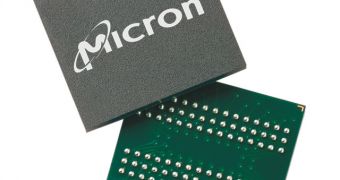Micron has just announced that it will soon expand its memory product portfolio with a new 64GB module that is specially designed to be used in server environments running memory intensive tasks.
More specifically, the 64GB module was developed for cloud computing, high-performance computing, Web servers, transactional databases, and data analytics applications.
Compared to the regular high-density memory solutions available at this time, Micron's upcoming creation is said to reduce power requirements by nearly 10 percent per DIMM, resulting in impressive energy savings while also providing higher capacity.
In order to build a 64GB DDR3 module, Micron used the LRDIMM (load reduced dual-inline memory modules) technology which replaces the regular memory register with a buffer chip (or chips).
"With leading companies like Micron, it's exciting to see LRDIMMs become a reality," said Paul Washkewicz, Vice President of Marketing, Computing and Storage at Inphi Corporation.
"For the past two years, we worked with Micron, one of our key partners, in the development of their LRDIMMs using our Isolation Memory Buffer (iMB) technology.
“Our collaborative effort has enabled a significant increase in memory capacity and performance for DDR3 server systems, which datacenters are anxious to employ." concluded the company's rep.
Samples of Micron's new LRDIMMs are available in 8GB, 16GB, and 32GB capacities, while the 64GB modules are expected to become available in February 2012.
One of the first companies to utilize these new high-capacity LRDIMM memory modules will be Supermicro which wants to include it in its SuperServer range of platforms.
"Supermicro's LRDIMM-enhanced SuperServer solutions provide our customers with higher memory density, speed and performance for a cost-efficient, competitive business edge," said Wally Liaw, Supermicro's Vice President of Sales.
No details regarding pricing are available at this point in time, but more information is expected to become available as the modules get nearer to launch.

 14 DAY TRIAL //
14 DAY TRIAL //